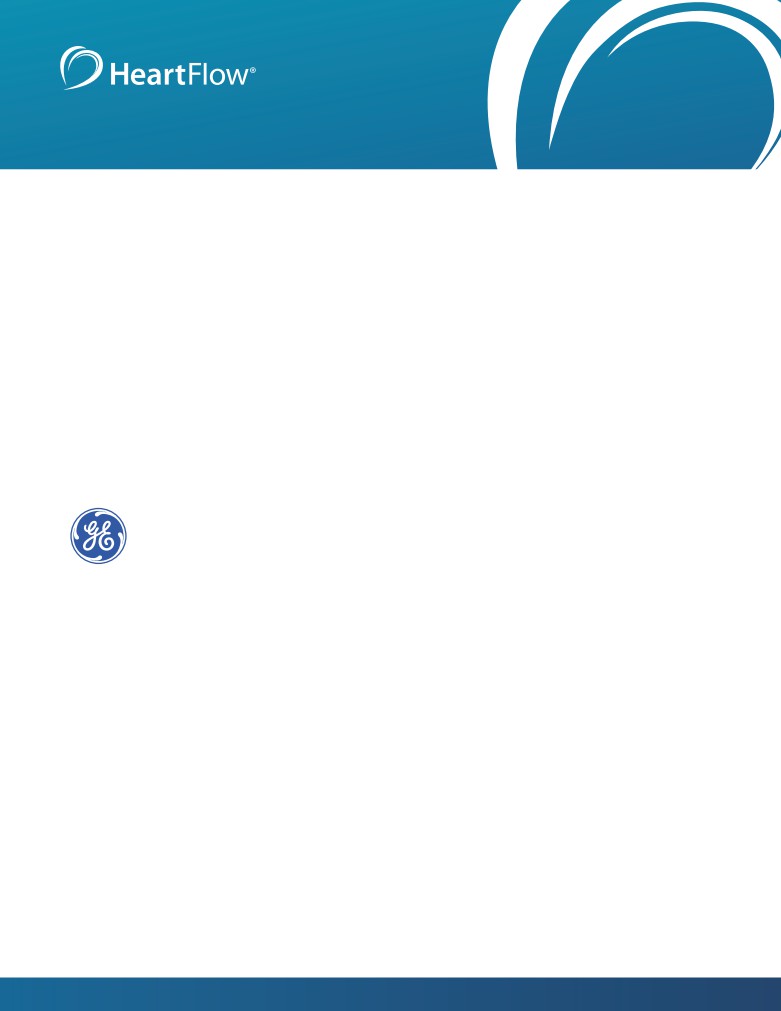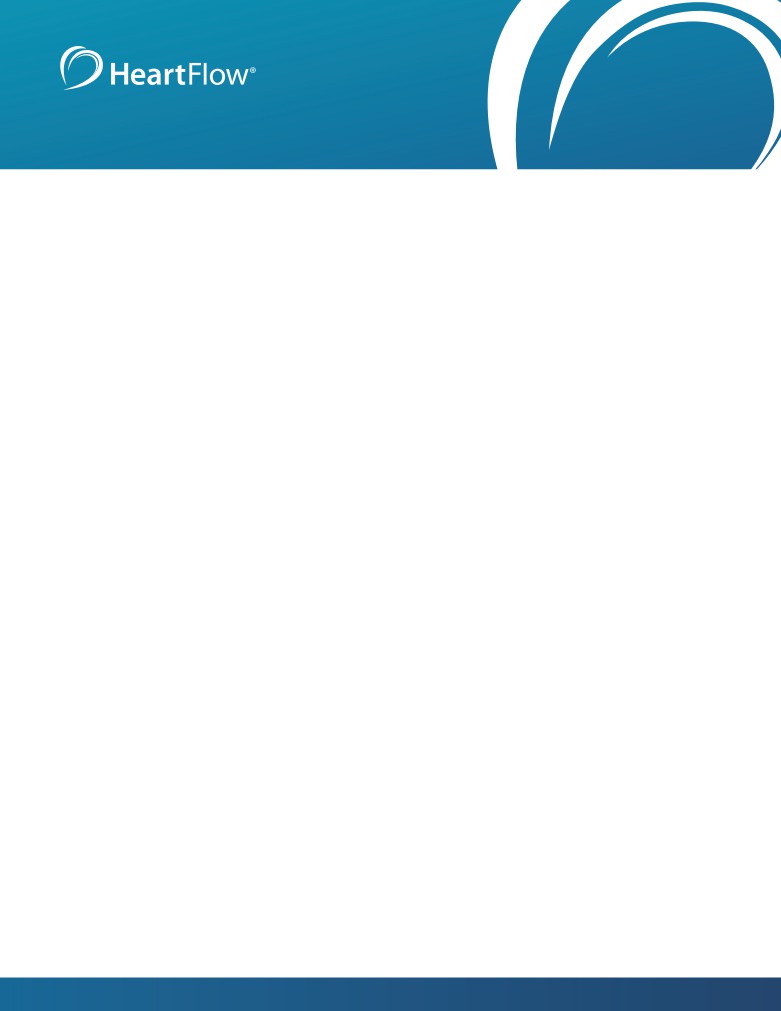Acquisition and
Reconstruction Techniques for
Coronary CT Angiography
GE Healthcare Scanner Platforms
Education Collaborator
GE Healthcare
Edited and Approved by
Jonathon Leipsic MD FSCCT
Past-President Society of Cardiovascular CT
1400 Seaport Blvd, Building B
| Redwood City, CA 94063
ph: +1.650.241.1221
| info@heartflow.com
| heartflow.com
15991220 V3
Table of Contents
1. Overview
3
2. Introduction
4
Importance of Heart Rate Control
4
Importance of Nitrates
4
Selection of Tube Current and Potential
5
3. Reference Protocol: Revolution™ CT ES and/or EX
6
Scout
6
ECG-gated Axial Data Acquisition of the Coronaries/Heart
6
Scan Parameters
6
Contrast Protocol
8
4. Reference Protocol: CardioGraphe
9
Scout
9
ECG-gated Axial Data Acquisition of the Coronaries/Heart
9
Scan Parameters
10
Contrast Protocol
11
Recommended mA and kV based on the patient’s BMI
11
5. Reference Protocol: Revolution HD, Revolution EVO, Optima™ CT660,
Discovery™ CT750 HD and LightSpeed™ VCT™ Scanner Platforms
12
Scout
12
ECG-gated Axial Data Acquisition of the Coronaries/Heart (Group 1)
12
Scan Parameters
13
Contrast Protocol
14
Review of Data Reconstruction and ECG-Editing
14
6. Bibliography
15
HeartFlow, Inc.
| Acquisition and Reconstruction Techniques for Coronary CT Angiography: GE Healthcare Scanner Platforms
|
15991220 V3
2
1. Overview
Coronary computed tomography angiography (CCTA) is a non-invasive diagnostic for detecting coronary
artery disease (CAD). CCTA is increasingly utilized in clinical practice for evaluating coronary anatomy for
obstructive disease and plaque.
It is, however, imperative that artifact free CCTA image data is obtained in order for it to be successfully
analysed for anatomic assessment and/or to act as adequate input for adjunct analyses such as physiologic
simulations. Data acquisition strategies and scanning protocols may vary depending on scanner manufacturer,
system, and institutional preferences. This document provides references for reliable image acquisition
for CCTA.
HeartFlow, Inc.
| Acquisition and Reconstruction Techniques for Coronary CT Angiography: GE Healthcare Scanner Platforms
|
15991220 V3
3
2. Introduction
Image acquisition in computed tomography is governed ultimately by the principle of As Low As Reasonably
Achievable (ALARA). In the first 10 years of CCTA, the focus was almost exclusively on the detection of
anatomical stenosis in low to intermediate risk patients. With the evolution of technology, the clinical utility
of CCTA has extended beyond stenosis assessment to atherosclerosis characterization, the evaluation of
structural heart disease, and the functional and physiological assessment of coronary stenoses. Recently
the SCCT acquisition guidelines were updated and provide an excellent reference for Cardiac CT imaging
specialists to help optimize their scan protocols. That being said, given the growing information that is
provided from cardiac CT, the imaging requirements have evolved and require tailoring to meet the clinical
indication. The purpose of this white paper is to highlight the parameters and image acquisition protocols that
are important to help optimize image quality, provide accurate representation of anatomy and thus enable
quantitative CT.
Importance of Heart Rate Control
With the advancements in scanner technology, the necessary requirement for heart rate reduction has
decreased over time. The demands for a low and steady heart rate to ensure diagnostic image quality may not
be what they once were but best practice remains to optimize image quality through heart rate control. SCCT
guidelines recommend performing CCTA with heart rates below 60 bpm.
In addition, CCTA no longer simply provides stenosis evaluation but needs to enable the interpreting physician
to identify and characterize plaque and, following the identification of a stenosis, to perform functional or
physiologic evaluation. As a result, while latest generation CT scanners may enable diagnostic image quality
at higher heart rates, there remains meaningful image quality benefits from heart rate reduction. In addition,
lower heart rates allow the use of lower dose scan acquisitions that are not possible at higher heart rates. Heart
rate control strategies are well established and the appropriate strategy is dependent on a number of variables
including available medications, setting of practice and site preference. For recommendations please refer to
the recently updated SCCT acquisition guidelines.
Importance of Nitrates
Nitrates as smooth muscle dilators have direct effect on coronary vasodilation and result in tangible
enlargement of coronary size. As such, similar to invasive coronary catheterization, nitroglycerine (glyceryl
trinitrate) should be administered prior to CCTA to optimize image quality and enable the most accurate
stenosis evaluation. A commonly used regimen is 400-800 µg of sublingual nitroglycerin administered as either
sublingual tablets or a metered lingual spray (commonly 1-2 tablets or 1-2 sprays) prior to the CCTA. While
the evidence is modest and there is no randomized data, both a higher dose and administration via spray are
becoming increasingly preferred in clinical practice and have been shown to help optimize coronary evaluation.
HeartFlow, Inc.
| Acquisition and Reconstruction Techniques for Coronary CT Angiography: GE Healthcare Scanner Platforms
|
15991220 V3
4
Selection of Tube Current and Potential
The scan parameters used for any cardiac CT should be tailored to the individual patient but also the intended
application. The image quality issues with the greatest impact on the interpretability of CT are misalignment
and image noise. As such, care must be given to ensure that image noise properties are appropriate and
adequate for accurate lumen segmentation. To do so, tube current and potential should be selected carefully,
guided by chest wall circumference, the iodine concentration of the intravenous contrast medium, and whether
iterative reconstruction is available or not.
Iterative reconstruction (IR) has the ability to reduce image noise in CT without compromising the diagnostic
quality of the CT image dataset, which permits a significant reduction in effective radiation dose. In current
clinical practice, IR has enabled a significant reduction in radiation dose by allowing for a reduction in tube
current and is now increasingly available across all cardiac capable CT scanners. IR commonly takes the form
of a blended reconstruction of IR and filtered back projection (FBP). While a very helpful tool, care should
be given when using a very high percentage of IR for quantitative CT analysis due to the potential impact on
vessel segmentation.
HeartFlow, Inc.
| Acquisition and Reconstruction Techniques for Coronary CT Angiography: GE Healthcare Scanner Platforms
|
15991220 V3
5
3. Reference Protocol: Revolution CT ES
and/or EX
1. Scout
General
Data Acquisition
Comment
Lateral and AP scout covering the
• Start: Superior 60 mm
Take note of the iso-center indicator
heart and coronaries
line on the first scout to ensure that
• End: Inferior 350 mm
the patient is positioned within
• Tube Current 10 mA
2 cm of isocenter to allow for best
• Tube Voltage: 120 kV
image quality. Adjust table height to
• ECG Trace: On
indicated iso-center location if more
• Scout Plane: 90 and 0 degrees
than 2 cm off before acquiring the
• Auto Voice: (Breath hold command) second scout.
2. ECG-gated Axial Data Acquisition of the Coronaries/Heart
Smart Prep
General
Data Acquisition
Comment
• Bolus tracking to automatically
• Monitoring Delay: 12 sec
The effective ‘diagnostic’ delay
trigger the diagnostic scan
• Monitoring Inter Scan Delay: 1 sec
between reaching the threshold
acquisition based on the HU
and the start of the subsequent data
• Tube Voltage: 120 kV
reading in the ROI reaching the
acquisition is the combined time
• Tube Current: 100 mA
prescribed enhancement threshold
comprising the autovoice, the time
• Diagnostic Delay: Auto minimum
• Slice Location: approx 2 cm below
needed for table movement.
• Threshold: 200 HU Enhancement
the carina
• ROI Location: Ascending aorta
Scan Parameters
General
Settings
Comment
• ECG-gated axial data acquisition of
Anatomy Selection:
The Auto Gating profile should be set
the heart
according to the goals of the study.
• Start Location: ~2 cm below the
For example, the GE CCTA is intended
• Scan range beginning 2 cm below
carina
for a routine CCTA study without
the carina to the base of the heart
• End Location: Base of heart
having full phases for functional
for routine CCTA without previous
• SFOV: Cardiac large
analysis.
CABG procedure
• DFOV: 25 cm
• Smart mA automatically sets
The auto gating profile will set phase
ECG & Gating:
the tube current to achieve the
acquisition window and HR variation
targeted Noise Index within the
• Auto Gating: On, GE CCTA
allowance.
range defined by the min and
• Gating Based On: Latest recording
“Latest recording” uses the ECG trace
max values
• Acquisition Window: Determined
information within the last test breath
• Noise index reference of 31 is
by HR
hold to determine target phases for
specific to the standard recon type
• HR Variation Allowance: 1 BPM
reconstruction. For example, if the
with ASiR-V of 50%
HeartFlow, Inc.
| Acquisition and Reconstruction Techniques for Coronary CT Angiography: GE Healthcare Scanner Platforms
|
15991220 V3
6
Scan Parameters (contd.)
General
Settings
Comment
• For systems with Cardiac Hi-Res
• Repeat Acquisition: On
HR was steady at 65 BPM the
scan modes, HD Standard, HD
• Adaptive Gating: On
acquisition window will be set to
Standard Plus and HD Detail
acquire a phase range of 70-80% of
• Smart Arrythmia Management: On
reconstruction kernels are
the R to R.
• Scan window:
recommended for patients with
Use ECG editing if necessary.
— Low HR (30-60 BPM): 75%
known high calcium scores, stents
— Moderate HR (71-70 BPM):
kV Assist - recommend adjusting the
or in general where body habitus
70-80%
minimum value to 100 kVp.
is appropriate
— Intermediate HR (71-85 BPM):
SnapShot Freeze is a optional feature
40-55% and 70-80%
that should be turned on if the HR is
— High HR (>85 BPM): 40-55%
>60 BPM.
kV and mA:
• kV Mode: kV Assist
• kV: Will be set by kV Assist
• mA Mode: Smart mA to achieve
targeted Noise Index
• Noise Index: 31
Timing:
• Auto Voice (Breath hold command):
On
• Pre-set Delay Time: 2 seconds
(Together with the auto voice
command and table movement,
this results in a diagnostic delay of
4-5 sec)
Scan Type:
• Scan Type: Cardiac
• Hi Res Mode: Off
• Rotation Speed: 0.28 seconds
Coverage Speed:
• Table Positions: One
• Detector Coverage:
SC:160 mm (Smart Collimation
will automatically select the
appropriate collimation for the
planned scan range)
Primary Recon:
• Thickness: 0.625 mm
• Recon Type: Stnd
• ASiR-V™: 50%
Secondary Recon:
• SmartPhase: On
HeartFlow, Inc.
| Acquisition and Reconstruction Techniques for Coronary CT Angiography: GE Healthcare Scanner Platforms
|
15991220 V3
7
Contrast Protocol
General
Specific
• Single contrast application for both
• For normal weighted patients and
Small Patients
the ECG-gated axial CTA of the
an iodinated contrast agent with
Test Bolus:
aortic root/heart and the CTA of the
300 mg/ml apply 30 ml contrast
• 4.5 cc/sec - 20 cc - contrast
thorax/abdomen/pelvis
at 3.5 ml/sec, followed by 60 ml of
• 4.5 cc/sec - 20 cc - saline
• Triphasic administration protocol
70% contrast/30% saline at
3.5 ml/sec, followed by 30 ml
CCTA:
with pure contrast, followed by a
contrast/saline mixture, followed by
saline at 3.5 ml/sec. This results
• 4.5 cc/sec - 20 cc - contrast
a saline chaser
in a total amount of 72 ml total
• 4.5 cc/sec - 42 cc -
contrast agent (adjust for contrast
• Placement of IV access per hospital
60% contrast/40% saline
agents with differing iodine
protocol (an 18-guage IV typically
• 4.5 cc/sec - 35 cc - saline
concentrations)
provides the highest safety)
• For large patients and an iodinated
Medium Patients
• Automated contrast injection using
contrast agent with 300 mg/ml
Test Bolus:
a dual-cylinder injector
apply 40 ml contrast at
• 5.5 cc/sec - 20 cc - contrast
4.0 ml/sec, followed by 80 ml of
• 5.5 cc/sec - 20 cc - saline
70% contrast/30% saline at
4.0 ml/sec, followed by 30 ml
CCTA:
saline at 4.0 ml/sec. This results
• 5.5 cc/sec - 20 cc - contrast
in a total amount of 96 ml total
• 5.5 cc/sec - 50 cc -
contrast agent (adjust for contrast
60% contrast/40% saline
agents with differing iodine
• 5.5 cc/sec - 40 cc - saline
concentrations)
Large Patients
Test Bolus:
• 6.5 cc/sec - 20 cc - contrast
• 6.5 cc/sec - 20 cc - saline
CCTA:
• 6.5 cc/sec - 60 cc - contrast
• 6.5 cc/sec - 60cc - 60% contrast/40%
saline
• 6.5 cc/sec - 50 cc - saline
HeartFlow, Inc.
| Acquisition and Reconstruction Techniques for Coronary CT Angiography: GE Healthcare Scanner Platforms
|
15991220 V3
8
4. Reference Protocol: CardioGraphe
1. Scout
General
Data Acquisition
Comment
Lateral and AP scout covering the
• Start: Superior 60
Take note on the scouts to ensure that
heart and coronaries
• End: Inferior 300
the patient is positioned within 2 cm
of isocenter to allow for best image
• Tube Current 20 mA
quality. Adjust table height and lateral
• Tube Voltage: 120 kV
table location to adjust iso-center
• ECG Trace: On
location if more than 2 cm off.
• Scout Plane: 90 and 0 degrees
• Auto Voice: (Breath hold command)
2. ECG-gated Axial Data Acquisition of the Coronaries/Heart
Smart Prep
General
Data Acquisition
Comment
• Bolus tracking to automatically
• Monitoring Delay: 12 sec
The effective (‘diagnostic’) delay
trigger the diagnostic scan
between reaching the threshold
• Monitoring Inter Scan Delay: 2 sec
acquisition based on the HU
and the start of the subsequent data
• Tube voltage: 100 kV
reading in the ROI reaching the
acquisition is the combined time
• Tube current: 60 mA
prescribed enhancement threshold
comprising (breath hold commands)
• Diagnostic Delay: 5 sec
and the time needed for table
• Slice location: approx 2 cm below
• Threshold: 200 HU Enhancement
movement
the carina
• Auto Voice (Breath hold
• ROI location: Ascending aorta
command): “Breathe in and hold
NOTE: the kV and Rotation Time
your breath”
parameters in the SmartPrep and
diagnostic scan tasks have to be the
same.
HeartFlow, Inc.
| Acquisition and Reconstruction Techniques for Coronary CT Angiography: GE Healthcare Scanner Platforms
|
15991220 V3
9
Scan Parameters
General
Settings
Comment
• ECG-gated axial data acquisition
Anatomy Selection:
Use the ECG trace information within
of the heart
• Start location: ~2cm below the
the last test breath hold to determine
•
Scan range beginning 2 cm below
carina
target phases for reconstruction.
the carina to the base of the heart
For example, if the HR was steady at
• End location: base of heart
for routine CCTA without previous
65 beats per minute the acquisition
• SFOV: 25 cm
CABG procedure
window will be set to acquire a phase
• DFOV: 25 cm
range of 70-80% of the R to R.
•
mA set achieve the targeted
ECG & Gating
Noise Index
Recommendation: SnapShot Freeze
• Acquisition Window: determined
is an optional feature that should
by HR
be turned on if HR is >60 BPM.
• HR Variation Allowance: 1 BPM
Reconstruct off line.
• Arrythmia Retriggering: On
kV and mA
• kV: 100-120 (see table on page 11)
• mA: 400-600 (see table on page 11)
• (Breath hold command):
• Pre-set Delay Time: 5 seconds
(Together with Breath hold
command and table movement,
this results in a diagnostic delay
5 sec)
Scan Type:
• Scan Type: Cardiac
• Hi Res Mode: Off
• Rotation Speed: 0.24 seconds
(slower for very large patients with
a low heart rate)
Coverage Speed:
• Table Positions: One
• Detector Coverage:
• Number of Passes: 1
Primary Recon:
• Thickness: 0.5mm
• Recon Type: Stnd
• ASiR-CV™: 70%
Secondary Recon:
• Off line
HeartFlow, Inc.
| Acquisition and Reconstruction Techniques for Coronary CT Angiography: GE Healthcare Scanner Platforms
|
15991220 V3
10
Contrast Protocol
General
Specific
• Single contrast application for both
• For normal weighted patients
• For large patients and an iodinated
the ECG-gated axial CTA of the
and an iodinated contrast agent
contrast agent with 350-370 mg/
aortic root/heart and the CTA of the
with 350-370 mg/ml apply 30
ml apply 40 ml contrast at 7 ml/
thorax/abdomen/pelvis
ml contrast at 6 ml/sec, followed
sec, followed by 70 ml of 70%
• Triphasic administration protocol
by 60 ml of 70% contrast/30%
contrast/30% saline at 7 ml/sec,
with pure contrast, followed by a
saline at 6 ml/sec, followed by 30
followed by 30 ml saline at 7ml/sec;
contrast/saline mixture, followed by
ml saline at 6 ml/sec; this results
this results in a total amount of 86
a saline chaser
in a total amount of 72 ml total
ml total contrast agent (adjust for
contrast agent (adjust for contrast
contrast agents with differing iodine
• Placement of IV access per hospital
agents with differing iodine
concentrations)
protocol (an 18-guage IV typically
concentrations)
provides the highest safety)
350-370 mg/ml
• Automated contrast injection using
350-370 mg/ml
7 ml/sec of 70 ml contrast
a dual-cylinder injector
6 ml/ sec of 70ml contrast
7 ml/sec of 50 ml saline
6 ml/ sec of 50 ml saline
Recommended mA and kV based on the patient’s BMI:
BMI
kV
mA
Gantry Rotation
ASiR-CV
< 21
100
350
0.24
70%
21-23
100
400
0.24
70%
23-25
100
500
0.24
70%
25-28
100
600
0.24
70%
29-34
120
480
0.24
90%
>35*
120
600
0.33
90%
*Heart rate > 60 BPM for patients with high BMI may result in images with high degree of coronary motion
HeartFlow, Inc.
| Acquisition and Reconstruction Techniques for Coronary CT Angiography: GE Healthcare Scanner Platforms
|
15991220 V3
11
5. Reference Protocol: Revolution HD,
Revolution EVO, Optima CT660,
Discovery CT750 HD and LightSpeed VCT
Scanner Platforms
1. Scout
General
Data Acquisition
Comment
Lateral and AP scout covering the
• Start: Superior 60
heart and coronaries
• End: Inferior 300
• Tube Current 20 mA
• Tube Voltage: 120 kV
• ECG Trace: On
• Scout Plane: 90 and 0 degrees
• Auto Voice: (Breath hold command)
2. ECG-gated Axial Data Acquisition of the Coronaries/Heart (Group 1)
Smart Prep
General
Data Acquisition
Comment
• Bolus tracking to automatically
• Monitoring Delay: 7 sec
trigger the diagnostic scan
• Tube Current: 60 mA
acquisition based on the HU
• Diagnostic Delay: Auto minimum
reading in the ROI reaching the
• Pre-set Delay Time: 3 seconds
prescribed enhancement threshold
(this results in a ‘diagnostic
• Slice Location: approx 2 cm below
delay’ of approximately 5-6 sec,
the carina
if rotation time is kept identical
• ROI Location: ascending aorta
between both groups, i.e. 0.4 sec)
• Enhancement Threshold: 150 HU
HeartFlow, Inc.
| Acquisition and Reconstruction Techniques for Coronary CT Angiography: GE Healthcare Scanner Platforms
|
15991220 V3
12
Scan Parameters
Data Acquisition Differences With
General
Data Acquisition Prospective Gating
Retrospective Gating
• ECG-gated acquisition of the
• Scan Type: Cardiac
• Cardiac Mode: SnapShot Segment
aortic root and heart. Scan range
(Helical)
• Cardiac Mode: SnapShot Pulse
beginning 2 cm below the carina to
(Cine)
— <80 bpm: SnapShot Segment
the base of the heart typically.
• Rotation Speed: 0.35 sec
— >80 bpm: SnapShot Burst
• Snapshot™ Pulse is a prospective
• Slice/Collimation: 0.625 mm
• HR Override: Off (turn on to
gating approach that is best suited
• SFOV: Cardiac large
manually enter min HR present on
for coronary imaging when the HR
the ECG trace when irregular HR’s
• DFOV: 25 cm
is <64 bpm and stable. It is typically
are seen)
the lowest dose imaging option for
• Tube Voltage
• Pitch: Autopitch (determined
CCTA.
— 120 kVp for BMI > 25 kg/m2
by HR)
• SnapShot Segment & Burst are
— 100 kVp for BMI < 25 kg/m2
• ECG Dose modulation: On
retrospective gating options which
• mA (manual):
provide more flexibility in phases
• Target phases with peak mA:
450/600/700 mA for small,
for reconstruction which is helpful
— 70-80% for HR <64 typically
average and large patients at
in higher HR or unstable HRs
120 kVp
— 40-80% for HR 65-75 typically
• mA ranges will vary based on
• Target Phase reconstruction:
— 40% for HR > 75 typically
individual scanner configurations
— 75% for HR <64 typically
Recon 2:
• For systems with Cardiac Hi-Res
• Recon Type: Stnd
• Recon Option; SnapShot Segment
scan modes HD Standard, HD
• Recon Option: ASiR, Slice 50%
Plus recon
Standard Plus and HD Detail
reconstruction kernels are
• Auto Voice (Breath hold command)
• Can also prescribe additional phases
recommended for patients with
for reconstruction within additional
known high calcium scores, stents
recon prescriptions
or in general where body habitus
Using the HR override capability with
is appropriate
manually setting the HR to a lower
• Noise Index reference of 31 is
value, yields a lower pitch value
specific to the standard recon type
which results in redundant CT data
acquisition (and increased radiation
dose). This provides the greatest
flexibility in image reconstruction
(e.g. utilization of SnapShot Segment,
SnapShot Burst or SnapShot Burst
Plus) which can be helpful in
challenging heartrate scenarios.
HeartFlow, Inc.
| Acquisition and Reconstruction Techniques for Coronary CT Angiography: GE Healthcare Scanner Platforms
|
15991220 V3
13
Contrast Protocol
General
Specific
• Single contrast application for the
• For normal weighted patients and
Small Patients
retrospectively ECG-gated axial
an iodinated contrast agent with
Test Bolus:
CTA of the heart
300 mg/ml apply 30 ml contrast at
• 4.5 cc/sec - 20 cc - contrast
• Triphasic administration protocol
3.5 ml/sec, followed by 60 ml
• 4.5 cc/sec - 20 cc - saline
with pure contrast, followed by a
of 70% contrast/30% saline at
3.5 ml/sec, followed by 30 ml
CCTA:
contrast/saline mixture, followed by
a saline chaser
saline at 3.5 ml/sec. This results
• 4.5 cc/sec - 20 cc - contrast
in a total amount of 72 ml total
• Placement of IV access per hospital
• 4.5 cc/sec - 42 cc -
contrast agent (adjust for contrast
protocol (an 18-guage IV typically
60% contrast/40% saline
agents with differing iodine
provides the highest safety)
• 4.5 cc/sec - 35 cc - saline
concentrations)
• Automated contrast injection using
• For large patients and an iodinated
Medium Patients
a dual-cylinder injector
contrast agent with 300 mg/ml
Test Bolus:
apply 40 ml contrast at
• 5.5 cc/sec - 20 cc - contrast
4.0 ml/ sec, followed by 80 ml of
• 5.5 cc/sec - 20 cc - saline
70% contrast/30% saline at
CCTA:
4.0 ml/sec, followed by 30 ml
saline at 4.0 ml/ sec. This results
• 5.5 cc/sec - 20 cc - contrast
in a total amount of 96 ml total
• 5.5 cc/sec - 50 cc -
contrast agent (adjust for contrast
60% contrast/40% saline
agents with differing iodine
• 5.5 cc/sec - 40 cc - saline
concentrations)
Large Patients
Test Bolus:
• 6.5 cc/sec - 20 cc - contrast
• 6.5 cc/sec - 20 cc - saline
CCTA:
• 6.5 cc/sec - 60 cc - contrast
• 6.5 cc/sec - 60 cc -
60% contrast/40% saline
• 6.5 cc/sec - 50cc - saline
Review of Data Reconstruction and ECG-Editing
• Image reconstructions of the heart should be reviewed immediately after the scan when the raw data
are still available
• The ECG-gating should be reviewed to ensure that the automated algorithms correctly identified
the R-peaks
HeartFlow, Inc.
| Acquisition and Reconstruction Techniques for Coronary CT Angiography: GE Healthcare Scanner Platforms
|
15991220 V3
14
6. Bibliography
1.
Dewey M, Hoffmann H, Hamm B. Multislice CT coronary angiography: effect of sublingual nitroglycerine
on the diameter of coronary arteries. RoFo: Fortschritte auf dem Gebiete der Rontgenstrahlen und der
Nuklearmedizin. 2006;178(6):600-4.
2.
Decramer I, Vanhoenacker PK, Sarno G, Van Hoe L, Bladt O, Wijns W, et al. Effects of sublingual
nitroglycerin on coronary lumen diameter and number of visualized septal branches on 64-MDCT
angiography. American Journal of Roentgenology. 2008;190(1):219-25.
3.
Laslett LJ, Baker L. Sublingual nitroglycerin administered by spray versus tablet: comparative timing of
hemodynamic effects. Cardiology. 1990;77(4):303-10.
4.
Bachmann KF, Gansser RE. Nitroglycerin oral spray: evaluation of its coronary artery dilative action by
quantitative angiography. The American Journal of Cardiology. 1988;61(9):7E-11E.
5.
Sato K, et al. Optimal starting time of acquisition and feasibility of complementary administration of
nitroglycerin with intravenous beta-blocker in multislice computed tomography. JCCT. 2009;33(2):193.
6.
Abbara S, Blanke P, Maroules CD, Cheezum M, Choi AD, Han BK, Marwan M, Naoum C, Norgaard BL,
Rubinshtein R, Schoenhagen P, Villines T, Leipsic J. SCCT guidelines for the performance and acquisition
of coronary computed tomographic angiography: A report of the society of Cardiovascular Computed
Tomography Guidelines Committee: Endorsed by the North American Society for Cardiovascular Imaging
(NASCI). J Cardiovasc Comput Tomogr. 2016 Oct 12. pii: S1934-5925(16)30239-8.
7.
Leipsic J, Abbara S, Achenbach S, Cury R, Earls JP, Mancini GJ, et al. SCCT guidelines for the interpretation
and reporting of coronary CT angiography: a report of the Society of Cardiovascular Computed
Tomography Guidelines Committee. Journal of cardiovascular computed tomography. 2014;8(5):342-58.
8.
Budoff MJ, Dowe D, Jollis JG, Gitter M, Sutherland J, Halamert E, et al. Diagnostic performance of
64-multidetector row coronary computed tomographic angiography for evaluation of coronary artery
stenosis in individuals without known coronary artery disease: results from the prospective multicenter
ACCURACY (Assessment by Coronary Computed Tomographic Angiography of Individuals Undergoing
Invasive Coronary Angiography) trial. Journal of the American College of Cardiology. 2008;52(21):1724-32.
9.
Meijboom WB, Meijs MF, Schuijf JD, Cramer MJ, Mollet NR, van Mieghem CA, et al. Diagnostic accuracy
of 64-slice computed tomography coronary angiography: a prospective, multicenter, multivendor study.
Journal of the American College of Cardiology. 2008;52(25):2135-44.
10. Miller JM, Rochitte CE, Dewey M, Arbab-Zadeh A, Niinuma H, Gottlieb I, et al. Diagnostic performance of
coronary angiography by 64-row CT. The New England journal of medicine. 2008;359(22):2324-36.
HeartFlow, Inc.
| Acquisition and Reconstruction Techniques for Coronary CT Angiography: GE Healthcare Scanner Platforms
|
15991220 V3
15
This paper is presented as a service to medical personnel by HeartFlow and GE. The information in this white paper has been compiled
from available literature and best practices from expert users. Although every effort has been made to faithfully convey this information, the
editors and publisher are not responsible for the content of the materials cited in this paper. This paper is not intended to be, and should not
be construed as, medical advice. For any use, the product information guides, inserts, and operation manuals of the various CT acquisition
devices should be consulted. HeartFlow and the editors disclaim any liability arising directly or indirectly from the use of drugs, devices,
techniques, or procedures described in this paper.
WARNING: Any references to x-ray exposure, intravenous contrast dosage, and other medication are intended as reference guidelines only.
The guidelines in this document do not substitute for the judgment of a trained healthcare provider. Each scan requires medical judgment by
the healthcare provider about exposing the patient to ionizing radiation. Use the As Low As Reasonably Achievable (ALARA) radiation dose
principle to balance factors such as the patient’s condition, size and age; region to be imaged; and diagnostic task.
HeartFlow, Inc.
| Acquisition and Reconstruction Techniques for Coronary CT Angiography: GE Healthcare Scanner Platforms
|
15991220 V3
16
1400 Seaport Blvd, Building B
| Redwood City, CA 94063
ph: +1.650.241.1221
| info@heartflow.com
| heartflow.com
© 2019 HeartFlow, Inc. HeartFlow and the HeartFlow logo are among trademarks of HeartFlow, Inc.
GE, GE Monogram, Revolution, Discovery, Optima, ASiR-V, SnapShot and LightSpeed VCT are trademarks of General Electric Company.
Revolution HD is a commercial configuration of Revolution Discovery CT.
15991220 V3
















